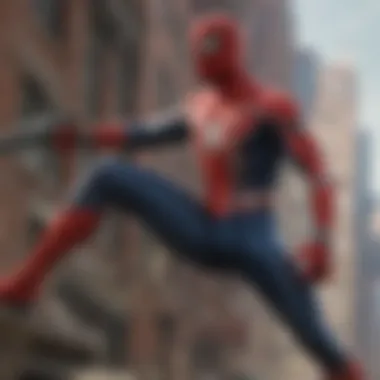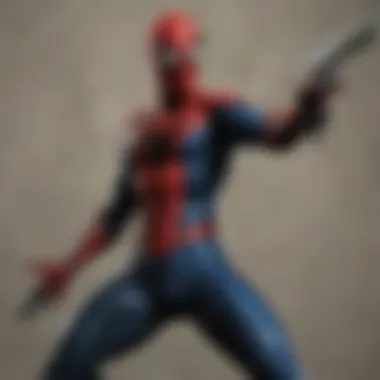Exploring Spider-Man with a Firearm: Contexts and Impacts


Intro
The character of Spider-Man has always stood on the aims of heroism and responsibility, embodying the mantra of using one’s powers for good. But what happens when that image is flipped on its backside? The concept of Spider-Man wielding a gun raises eyebrows and ignites debate among fans and critics alike. This article dives into the far-reaching implications of introducing firearms into the narrative of one of the most cherished superheroes. By examining the character's history, the reactions of both audiences and creators, as well as the broader cultural discussions surrounding violence and gun usage in comic books, we aim to shed light on this provocative reinterpretation.
Spider-Man Character Analysis
Background
Spider-Man first swung onto the scene in 1962, thanks to Stan Lee and Steve Ditko. From a humble high school student plagued by the typical issues of adolescence, Peter Parker's life drastically changed after a bite from a radioactive spider. This moment not only granted him superhuman abilities but also changed the trajectory of superhero storytelling. Unlike many of his predecessors, Spider-Man faced personal struggles and experiences that resonated with readers, making him relatable on more levels than one.
The evolution of Spider-Man since the early days is nothing short of remarkable. He has transitioned from the pages of comic books into blockbuster films, animated series, and video games. His character continues to grow, tackling contemporary issues while remaining true to his roots in some iterations.
Powers and Abilities
Spider-Man boasts an impressive arsenal of powers, which have rendered him one of the most formidable superheroes in the Marvel Universe. His abilities include:
- Superhuman Strength: He can lift heavy objects, making him capable of great physical feats.
- Wall-Crawling: True to his name, Spider-Man can adhere to surfaces and defy gravity in ways ordinary humans cannot.
- Spider-Sense: This heightened intuition alerts him to imminent danger, allowing him to react swiftly.
- Web-Slinging: With self-manufactured web-shooters, Spider-Man navigates the urban landscape with exceptional agility.
These abilities combined with Peter's intellect and ingenuity make him a unique and complex character. However, the introduction of a firearm into this dynamic would not just add another tool to his belt but would fundamentally alter his role and identity.
Character Development
Character growth for Spider-Man is replete with key moments that shaped him significantly. The mantra of "With great power comes great responsibility" remains a cornerstone to his character arc. One notable turning point was the loss of Uncle Ben, which spiraled Peter into a path of moral introspection, cementing his role as a hero.
However, introducing a gun changes the stakes and motivations. For a character who has consistently chosen restraint and compassion over brute force, the act of using a firearm could signify a dramatic shift. Would it symbolize a loss of innocence or perhaps a moment of desperation? These questions present a fertile ground for analysis, contrasting sharply with Spider-Man's long-established ethos.
"In essence, Spider-Man's character is built on the juxtaposition of power and morality. Shifting this balance with a firearm could lead to troubling interpretations."
The intersection of guns and superhero narratives opens a Pandora's box of themes, from vigilantism to justice, each demanding to be explored in-depth.
By closely examining these dynamics, the implications of such a drastic alteration to Spider-Man's character become clearer. It raises the curtain on a broader conversation: how far can a beloved hero stray from their core values before losing their identity altogether?
Latest Spider-Man News Update
Comic Books
Recent comic book issues have seen Spider-Man navigating complex storylines where his ethics are tested, sometimes venturing towards darker themes. The latest arcs delve deeper into his relationship with technology and how it can both benefit and hinder his mission.
Movies
With several Spider-Man movies in the pipeline, the casting choices continue to stir discussions. The portrayal of Spider-Man has evolved across different actors, each bringing their unique touch. Fans are eagerly anticipating the next installment, which is rumored to feature even more mature themes and complexities in Peter's character.
Video Games
Both established franchises and fresh offerings have been hitting the gaming market, with an increasing focus on narrative depth. The new titles are expected to immerse players in moral dilemmas, forcing them to make choices that reflect Spider-Man's core values—and potential contradictions, should a firearm be introduced into the gameplay.
Top Villains in Spider-Man Universe
Main Antagonists
Spider-Man's universe is littered with a rogues' gallery of villains, each contributing to the ongoing narrative tension. Notable adversaries like Green Goblin, Doctor Octopus, and Venom have shaped many of Spider-Man's most defining moments.
Origins and Motivations
Understanding what drives these characters provides insight into Spider-Man's challenges. For instance, Green Goblin embodies chaos and madness, contrasting with Spider-Man's underlying order. This juxtaposition often lays the groundwork for intense personal and physical confrontations.
Memorable Battles
The battles Spider-Man engages in with his villains are not just physical flights but emotional struggle too. The iconic clashes—whether on the rooftops of New York or within the confines of his psyche—reflect broader themes of responsibility, loss, and the struggle between good and evil.
Spider-Man Movie Reviews
Plot Summary
As new Spider-Man movies are released, audiences are treated to storylines that intertwine humor, tragedy, and action. Each film attempts to further explore where Peter fits in an ever-evolving world.
Character Portrayals
The lead characters are often brought to life with exceptional performances, with actors investing themselves fully into the complexity of Peter Parker. Supporting characters often enrich the storyline, providing additional layers that complicate Spider-Man's journey.


Visual Effects
The advancements in CGI and action sequences have kept audiences on the edge of their seats. These visual elements are not mere spectacle; they serve to amplify the emotional weight and thematic richness of Spider-Man lore.
This exploration of Spider-Man with a gun brings us to the edge of a pivotal conversation. Can a character built on the tenets of restraint and empathy delve into realms typically reserved for darker narratives? What does this say about the evolving landscape of superhero storytelling? Only time will tell how this bold interpretation will influence the future of Spider-Man and his enduring legacy.
Intro
The discussion surrounding Spider-Man—a character deeply ingrained in pop culture—takes an intriguing turn when a firearm is introduced into the equation. The ability to reimagine Spider-Man with a gun opens up a multitude of avenues for exploration regarding themes such as power, responsibility, and morality. Such a portrayal shifts our understanding of heroism and what it means to protect the innocent in a world often fraught with chaos. By examining these implications, we delve into how such character transformations might influence audience perceptions and alter the narrative landscape of superhero storytelling.
This article ventures beyond surface-level interpretations, diving into the historical and cultural contexts that frame the Spider-Man mythos. Changes in societal attitudes towards violence and the acceptance of firearms in cinematic and comic narratives play crucial roles in shaping how Spider-Man is perceived. Considering the evolution of Spider-Man sheds light on the character's flexibility in adapting to contemporary issues faced by society.
Whether it's through comic books, television shows, or films, analyzing the implications of a gun-wielding Spider-Man reveals a direct correlation with the ongoing discourse about morality in heroism. This examination aims to enrich the reader's understanding, encouraging nuanced discussions about the direction of superhero narratives in general.
The Evolution of Spider-Man
Spider-Man, created by Stan Lee and Steve Ditko in 1962, initially emerged as the quintessential relatable hero, embodying the trials and tribulations of adolescence. His character faced ordinary challenges—love, school, and the daily grind—juxtaposed with the extraordinary responsibility of combating villains. Over decades, though, the world has seen significant changes that have influenced the portrayal of Spider-Man.
To begin with, comic books often mirrored societal events. From the civil rights movement to the rise of anti-hero narratives in the late 20th century, Spider-Man has evolved in response to these shifts. Characters have become increasingly complex, navigating grey moral areas rather than black and white distinctions.
Moreover, the gradual acceptance of firearms in comic book narratives aligned with societal attitudes towards weapons, evident in numerous story arcs where characters wield guns out of necessity or desperation. As Spider-Man faced more formidable foes, the line blurred between traditional heroism and adopting countermeasures that could be seen as morally ambiguous.
In an era of heightened realism—where the lines between hero and villain are often obscured—there's a compelling argument for Spider-Man evolving into a version who may resort to using a gun, reflecting a new breed of hero crafted under the pressures of contemporary conflicts.
Rethinking Heroism
The concept of
heroism is complex and often shifts with cultural tides. Spider-Man traditionally upheld the notion of ‘with great power comes great responsibility’, a motto underscoring restraint and moral duty. However, introducing a firearm into his arsenal raises pertinent questions: Does it still uphold the ethos of heroism, or does it signal a significant departure?
In this rethinking, we may recognize that the inclusion of a gun could encapsulate the harsh realities of the modern world, portraying a hero shaped by circumstances more than ideals. This dissatisfaction with traditional notions of heroism is mirrored across modern media, where heroes frequently grapple with their choices and moral implications. By engaging with difficult themes, Spider-Man could transition to embody a more gritty, morally compromised figure, inviting discussions around the moral flexibility of heroes in such times.
Each iteration of Spider-Man reminds us that even the most beloved characters are reflections of their times. The discourse around a gun-wielding Spider-Man transcends mere curiosity—it compels us to reconsider what heroism means in today’s cinema and literature.
"Perhaps the ultimate test of a hero is not simply the absence of flaws, but how they reconcile their dualities in a world that demands both strength and integrity."
The Iconic Image of Spider-Man
Spider-Man stands as a symbol of resilience, complexity, and duality, resonating with fans around the globe. The character is not merely a hero clad in red and blue but represents an inner struggle woven into urban landscapes and moral dilemmas. The notion of Spider-Man with a gun complicates this iconic imagery, creating a jarring juxtaposition for long-time followers and casual observers alike. It invites us to consider how weapons alter perceptions of characters that typically embody justice and self-restraint.
The essence of Spider-Man’s iconic status lies in his relatability. He grapples with personal issues, facing everyday challenges while striving to uphold a moral code. This makes his character approachable, even in a fantastical realm. As we delve into representations of Spidey with a sidearm, it’s essential to recognize how such elements reshape this familiar narrative.
When viewing Spider-Man in a more violent light, several considerations emerge: the impact on character integrity, narrative coherence, and the potential alienation of die-hard fans. There’s a palpable tension between the traditional image of a hero and the implications of wielding firearms. Would this shift render him more human and flawed, or would it strip away the moral compass that defines him?
Gun imagery in superhero narratives is not entirely foreign; however, its application to a character like Spider-Man incites a new dialogue about the portrayal of violence in media. Could it reflect a darker reflection of contemporary society? In this way, examining the iconic image of Spider-Man sets the stage for a deeper understanding of the relationship between heroism and weaponry.
Symbolism of the Web-Slinger
Spider-Man’s web symbolizes connection, creativity, and freedom. He weaves intricate webs that signify his ability to navigate the complex world around him, be it physical or emotional. When firearms enter the equation, this symbolic landscape begins to shift. The interplay of webs and guns changes the dialogue about power dynamics.
- Tradition vs. Change: The original Spider-Man summoned grappling hooks and webs to combat foes, conveying resourcefulness and intelligence. This signifies a hero who relies on ingenuity rather than brute force.
- The Burden of Choice: A gun represents a choice fraught with consequence. Spider-Man's decision to use such a weapon could diminish his relatability and contradict the very essence of his persona.
One could also argue that introducing an instrument of death contrasts sharply with Spider-Man’s protective nature. It reveals internal discord—not just for the hero but for those who witness this transformation. It might be a signal of shifting cultural narratives that normalize violence, prompting a critical examination of the narratives we consume.
The Role of Weapons in Hero Narratives
Weapons have long been integral to superhero tales, serving as devices that reveal character traits, drive plot development, and frame moral questions. When scrutinizing Spider-Man's character arc with the addition of firearms, we must examine how this impacts his role in the larger superhero community.
- Morality at a Crossroads: The question arises—can a hero remain morally grounded while possessing lethal capabilities? Spider-Man's mantra, "With great power comes great responsibility," begins to unravel. The character risks losing his essence, as choices shift from saving lives to deciding who lives or dies.
- Cultural Reflections: Today, the portrayal of gun-wielding heroes can be seen as reflective of societal views on violence. Are these narratives desensitizing audiences or sparking critical conversations about real-world issues?
The integration of weapons into superhero narratives compels creators and audiences alike to grapple with the ethics of heroism and the portrayal of violence in media. When does a hero become a villain in the eyes of society?
Ultimately, exploring the role of weapons in narratives surrounding Spider-Man provokes thought on the delicate balance between tradition and modernity, leading to richer discussions about what it means to be a hero in an increasingly complex world.
Spider-Man in Comics
The portrayal of Spider-Man in comics serves as a foundational aspect of the character's identity and legacy. This section delves into the nuances of his relationship with firearms and how this dramatically affects both the narrative arc and the wider cultural context of comics. Understanding Spider-Man within the comic book medium also notices the contrast between traditional values associated with the hero and potential conflicts introduced by the notion of him wielding a gun.
Historical Context of Firearms


Historically, the integration of firearms in superhero comics is not just a mere plot mechanism. Guns have often reflected societal attitudes towards violence, heroism, and moral boundaries. While Spider-Man traditionally embodies a philosophy rooted in non-violence, safe-guarding the innocent and adhering to a strict code against killing, the evolution of his character in the comics coincides with shifts in public perception of firearms. During the 1980s and 1990s, as societal concerns over crime and gun violence intensified, comic writers began exploring darker themes, often letting their heroes interact with firearms to depict a more realistic world.
To appreciate the implications of Spider-Man with a gun, one must recognize how the comic industry has often mirrored the larger cultural landscape, leading to a necessity for characters to adapt to shifts in audience expectations. Additionally, the inclusion of firearms compels writers to examine the moral dilemmas characters face in an increasingly complex world.
Notable Storylines Featuring Guns
Several key storylines exemplify the transformation of Spider-Man’s character and his complex relationship with guns. Some noteworthy narratives include:
- "Kraven's Last Hunt": This seminal storyline not only showcases brutal realism but also explores Spider-Man’s vulnerabilities and the often-unbearable weight of responsibility. Kraven, the antagonist, threatens Peter Parker using not just physical might but the implied deadly use of firearms. Even though Spider-Man does not use a gun himself, the tension around weaponry is palpable, underscoring a deeper moral conflict police against villainy.
- "Ultimate Spider-Man": In this modern retelling, aspects of Spider-Man's character evolved to adapt a world more accepting of contemporary themes, including gun violence. Comics within this series enabled a more grounded take on Spider-Man, sometimes putting him in situations where the presence of guns had profound implications for his choices as a hero. A significant storyline depicted how his young, unpolished approach struggled against both petty crime and more severe threats armed with firearms.
- "Spider-Man: Reign": This limited series imagines a future where Spider-Man is an aging hero that has turned away from his heroic persona, at one point confronting a grim world filled with corruption, crime, and violence. The gun as a tool is presented in stark contrast to the man who was once an idealist. It raises questions about the hero’s decisions and what it means to live by a code in a world ruled by crime where guns have become commonplace.
These storylines not only provide entertainment but invite deeper reflections on themes of morality, power, and the responsibilities that come with such choices.
"The absence or presence of guns in storytelling often challenges our moral compass and reshapes the characters we think we know."
Thus, the topic of Spider-Man in comics is critical to understanding both the character’s evolution and the wider implications on hero narratives within the medium.
Cinematic Interpretations
The evolution of Spider-Man across various cinematic renditions holds significant weight in understanding how he is perceived by audiences. When placed in the context of wielding a firearm, we enter the domain where traditional heroism clashes with contemporary societal issues surrounding violence. Films explore not just the aesthetic but also the emotional resonance of such portrayals. By examining the implications of a gun-wielding Spider-Man within these cinematic frameworks, we can reveal the inner conflicts of power, responsibility, and morality that underpin the character.
Gun Imagery in Spider-Man Films
In the realm of Spider-Man films, recognition of gun imagery introduces a layer of complexity to the character’s narrative. For instance, in Spider-Man: Into the Spider-Verse, various iterations of Spider-People are portrayed, each confronting different aspects of their identities. While these versions stay true to the character's core values, the inclusion of firearms symbolizes a break from tradition. Would a Spider-Man with a gun still resonate with the notion of protecting rather than destroying?
Consider how such imagery can incite powerful emotion. A scene featuring Spider-Man aiming a gun at a villain might provoke immediate distrust. The iconic phrase "With great power comes great responsibility" suddenly feels moot in this context. These films require careful treatment of violence—the filmmakers tread a thin line, ensuring that character motivation remains grounded and morally justifiable.
"By the time you see Spider-Man with a gun, you recognize that the stakes are higher than you thought."
Comparison with Other Superheroes
When juxtaposing Spider-Man with other superheroes, we begin to see distinctive traits and thematic concerns. Take Batman, for example. His use of firearms—though not typical—often raises eyebrows yet finds justification within a narrative that continuously flirts with moral ambiguity. In contrast, Spider-Man traditionally embodies a lighter approach to heroism, even in the face of adversity.
This contrast shapes how audiences perceive gun usage. When characters like Deadpool embrace their violent nature humorously, Spider-Man's more earnest tone brings weight to the presence of a firearm. This creates a dichotomy that can either elevate or bury the character’s legacy. The cultural impact resonates, prompting deeper questions about violence in superhero narratives.
In summary, as we delve into the cinematic realm, the exploration of Spider-Man with a gun reveals broader thematic shifts that challenge established norms. Acknowledging these shifts opens the door to richer interpretations, all while urging fans to reassess the foundations of what it means to be a hero.
Cultural Implications of a Gun-Wielding Spider-Man
The topic of a gun-wielding Spider-Man raises complex cultural implications that are worth exploring. At its core, this transformation challenges not only the character’s essential principles but also reflects a broader societal dialogue about violence in media and its impact on audience perception. Superheroes like Spider-Man have often been viewed as icons of hope and responsibility. To equip such a character with a firearm tests the boundaries of these ideals and sheds light on contemporary concerns regarding heroism, violence, and morality in storytelling.
Shifts in Audience Perception
When discussing Spider-Man with a gun, one must consider how audiences might perceive this character differently. Traditionally, Spider-Man is the hero who famously adheres to the principle that with great power comes great responsibility. This axiom provides a moral compass even when conflict arises. Introducing firearms into his narrative could skew the audience's view of this foundational realization.
In recent years, comic book readers and cinema-goers alike have begun to embrace more shades of gray within character portrayals. The lines that traditionally distinguish heroes from villains have blurred, and audiences seem increasingly receptive to anti-hero characteristics. A gun-wielding Spider-Man may resonate with a demographic that appreciates darker, more complex narratives. This shift in audience perception could lead to:
- Increased Acceptance of Gray Morality: Viewers may begin to see Spider-Man not only as a hero but as a character grappling with morally ambiguous situations.
- Discussion on Justification of Violence: Audiences may delve into heated discussions regarding when, if ever, violence is justified, especially within the superhero context.
By introducing guns into their narratives, creators lead audiences to grapple with these themes, potentially leading to a more nuanced understanding of characterizing heroes in modern media.
Reflections on Violence and Morality
The contemplation of Spider-Man wielding a gun inevitably draws attention to cultural conversations surrounding violence and morality. Gun imagery in superhero stories often provokes strong emotional responses, sparking debates about the acceptability of gun use in these narratives.
A key aspect to consider is the distinction between portrayal and endorsement. Just because a character uses a gun does not mean the narrative promotes violence as a solution. Instead, it may serve as a means to explore the consequences of such actions, emphasizing the cost of power and its misuse.
A narrative featuring a gun-bearing Spider-Man fosters reflections on various issues:
- Impact on Younger Audiences: As Spider-Man is a figure beloved by many children, there’s concern about how gun use might influence impressionable minds. Would this shape their understanding of heroism in ways that prioritize aggression over responsibility?
- Moral Consequences: Heroic narratives often provide moral lessons. By placing a firearm in Spider-Man's hands, the story opens doors to discussions about the repercussions of violence, highlighting perhaps that actions have consequences, and even heroes can make grave mistakes.
- Cultural Context: In a society grappling with gun violence, rooting for a character who resorts to such means may evoke mixed feelings. Is it a sign of a cultural shift demanding more complex portrayals, or a reflection of a society desensitized to violence?
Character Dilemmas and Themes
The portrayal of Spider-Man grappling with the complexities of wielding a firearm reveals much about the intertwined nature of power and responsibility. This section seeks to unpack those layers, showcasing how the theme resonates through various narratives while offering insights into the character's psyche and evolution. By investigating these character dilemmas, we can gain a broader perspective on not just Spider-Man but also the very fabric of superhero storytelling.
The Conflict of Power and Responsibility
At the heart of Spider-Man's character lies the phrase, "With great power comes great responsibility." Traditionally, this mantra serves as a guiding star for his decision-making. However, introducing a gun into the equation complicates this adage immeasurably. In this context, one might question: does power corrupt? The weapon adds layers of moral ambiguity to his character, placing him at the crossroads of law and chaos.
A firearm represents a potential for lethal force, contrasting sharply with the character's usual tools and methods, which emphasize agility, stealth, and a non-lethal approach to conflict. The choice to embrace a gun can often be seen as an abandonment of the very principles that define Spider-Man’s ethos. Fans might find themselves torn. On one hand, there’s a thrilling notion of empowerment; on the other, the loss of what has historically kept the character grounded.


Moreover, the psychological ramifications of using a gun cannot be ignored. How does wielding such a brutal weapon affect Spider-Man’s mental state? The internal struggle could lead to an irrevocable change, blurring the lines of heroism and authority. The burden of such power manifests through fear of making irreversible decisions, leading to plotlines that delve deep into morality and consequence.
In the comics, we can see characters like Eddie Brock, who takes on the mantle of Anti-Venom. Their mutated forms serve as a cautionary tale of power misused. Consequently, Spider-Man's grappling with gun-related dilemmas falls in line with such narratives, emphasizing the cost of relying on potentially lethal means rather than his more inherent Web-Slinging techniques.
"The true hero is not defined by his power, but by his choices while wielding it."
Exploring Anti-Hero Traits
As Spider-Man shifts from a typical hero archetype to one embodying anti-hero characteristics, the narrative landscape opens up to fresh themes. The introduction of a gun transforms his image, resonating with audiences who might appreciate characters that embody deeper flaws and contradictions.
In the realm of anti-heroes, the critical question often revolves around justifications. Does using a gun signify a willingness to step into morally gray territories? If Spider-Man were to pull the trigger, does that make him a vigilante with a vendetta, rather than the quintessential hero meant to inspire hope?
The allure of anti-hero traits often lies in their relatability. Given the turmoil and moral quandaries we face in the real world, seeing Spider-Man navigate such ambiguity reflects our struggles as humans. A gun-wielding Spider-Man might symbolize our own inclination towards power, along with the associated risks of corruption and obsession.
Expanding on this concept, the narratives that feature Spider-Man grappling with these anti-hero qualities encourage discussions on ethics within heroism. Instead of merely portraying a figure of unblemished virtue, these storylines allow audiences to witness the tumultuous emotional canvas underlying the character's actions.
In essence, by bridging traditional superhero qualities with anti-hero traits, Spider-Man's adventures become a platform for examining our values. The nature of a hero is no longer black and white, blurring in ways that challenge audiences to rethink their own definitions of justice and morality. Whether one is cheering for Spider-Man or wrestling with his darker choices, the discussion remains potent and provocative.
Fan Responses and Community Reactions
When discussing a character as multifaceted as Spider-Man, it’s crucial to consider how fans respond to new interpretations, especially one as controversial as the notion of him wielding a firearm. The interaction between a hero's image and its reception by the audience reveals much about both the character's place in society and the values fans hold. The reactions from the community can shed light on shifting cultural norms, preferences in storytelling, and the broader implications of violence in media.
A Closer Look at Fan Art and Cosplay
Fan art and cosplay often serve as a window into how enthusiasts embrace or reject specific character traits and storylines. Within this context, interpretations of Spider-Man equipped with a gun have sparked a vibrant mix of creativity and critique. Artists rendering him in various styles can speak volumes about the acceptance of this new image in the canon. Some portrayals depict Spider-Man in dark, gritty settings, merging traditional elements of the character with modern themes of aggression and power.
- Divergent Styles: Fans might depict Spider-Man with firearms in diverse artistic styles ranging from hyper-realistic to abstract interpretations. Each style conveys unique emotional tones, influencing how others perceive this re-imagined hero.
- Cosplay Trends: Cosplayers often navigate the murky waters of this controversial depiction. While some embody this new version with pride, sporting customized suits adorned with holsters and props, others might opt for classic looks, resisting the allure of a gun-toting interpretation.
- Cultural Commentary: The creation and sharing of fan art often come with commentary on societal issues like violence, responsibility, or the portrayal of masculinity. A piece might provoke discussions that go beyond the character, examining how pop culture intersects with real-world issues.
This exploration of fan art illustrates not only engagement with the character but also social discourse surrounding the themes embodied by Spider-Man with a gun.
Discourse on Social Media
The landscape of social media provides a unique platform for discussions and debates among Spider-Man fans about this transformation. It acts like a digital town square where opinions can clash or harmonize, and it holds immense power in shaping the narrative. Twitter, Reddit, and other platforms have become battlegrounds for defending or opposing this portrayal.
- Vocal Opinions: Fans often share their thoughts on Twitter using hashtags or dedicated threads. The split among fans is palpable, with some praising the depth this new angle brings, while others feel it tarnishes the heroic essence that Spider-Man has stood for.
- Reddit Discussions: Subreddits dedicated to Spider-Man enthusiasts serve as venues for deeper dives into this controversial subject. Users engage in lengthy discussions, analyzing comic arcs or film scenes in which Spider-Man might have touched a gun. These discussions can offer civil reasoning as well as outright hostility.
- Engagement Metrics: Posts with images or references to Spider-Man with a gun can generate significant interaction. Measured by likes, comments, and shares, this indicates both the intrigue and contentious nature of the topic—as if fans are trying to gauge where everyone stands on this divide.
Ultimately, social media becomes a mirror reflecting broader societal attitudes toward heroism and violence, as the fan community grapples with the implications of its beloved character adopting such a drastic change.
The Future of Spider-Man Narratives
As we stand on the precipice of new storytelling techniques and artistic directions, the future of Spider-Man narratives looms large. In a world where expectations of heroes evolve, the role of Spider-Man with a gun opens the door to diverse themes in comic book lore. This stage sets the framework for how writers will navigate the waters of moral ambiguity and shifting audience perceptions. The presence of firearms within the Spider-Man universe can lead to a significant shift in the character's identity, presenting an opportunity for deeper explorations of conflict, responsibility, and societal issues.
Potential Impact on New Story Arcs
The introduction of a gun-wielding Spider-Man could radically alter the direction of story arcs moving forward. Traditional narratives focused heavily on the mantra of "With great power comes great responsibility." If Spider-Man embraces a firearm, this fundamental saying may be reexamined in various lights.
- Moral Complexity: Instead of solely finding non-lethal ways to tackle foes, Peter Parker might be drawn into morally gray areas. The stories could delve into the impact of using a gun on his psyche. Would he wrestle with the consequences of his actions more profoundly?
- The Villains' Responses: Enemies may not react the same way to a Spider-Man who carries a weapon. This could force major antagonists to rethink their strategies, adding layers to villainy and the dynamics of confrontations.
- Audience Engagement: Challenging fans' conventional views could boost engagement. Readers might find themselves participating in debates over what it means for Spider-Man to wield a gun. Such dialogues are bound to spark interest and broaden the community’s discourse around the character's evolution.
Exploring Diverse Interpretations
The portrayal of Spider-Man with a firearm invites an array of interpretations, from darker and grittier narratives to those that critique the very notion of violence in society. These interpretations can help to foster fresh perspectives, reflecting cultural anxieties or challenges.
- Cultural Reflections: In times of societal unrest or debates over gun control, using a gun as part of Spider-Man's arsenal can set a platform for broader discussions. Writers and filmmakers have a chance to reflect contemporary issues, weaving them into the fabric of Spider-Man’s universe.
- Artistic Styles: Different artistic portrayals could shape this narrative path. Some might take a lighter stance, creating a contrast between the Spider-Man's core personality and his actions, while others may lean into a darker tone, presenting a serious analysis of violence.
- Fan Reactions: Fans' interpretations will undoubtedly vary greatly. Some may embrace this transformation as a much-needed evolution, while others could vehemently oppose it, arguing it contradicts Spider-Man's altruistic nature. This friction could fuel discourse among fandoms and enrich the character's legacy.
Epilogue
In closing, this article delves deeply into the multifaceted identity of Spider-Man, especially through the provocative lens of him wielding a firearm. This exploration is not simply about the act of introducing a gun into the narrative, but rather it invites us to reassess what Spider-Man stands for in a larger sense. The importance of this reassessment lies in several critical elements that not only enhance our understanding of this beloved character but also illustrate broader themes across superhero storytelling.
Reassessing Spider-Man's Identity
Spider-Man has always represented the struggle between power and responsibility. His mantra, "With great power comes great responsibility," echoes throughout his stories. The introduction of a gun into his arsenal complicates this message. Does the act of using a firearm align with his core values? As we consider this, it's essential to highlight that adding a gun shifts the focus from physical agility and intelligence to a reliance on fatal force. The symbolism of his web-slinging and sticky fingers fundamentally clashes with the implications of lethal weaponry. This may prompt veteran fans to argue that it tarnishes the essence of who Spider-Man is.
Conversely, depicting Spider-Man with a gun could reflect contemporary issues in society, where dilemmas surrounding power dynamics, moral ambiguity, and the consequences of violence are increasingly relevant. This duality invites a fresh dialogue among audiences— one that challenges how we perceive heroism, choice, and ethics. Exploring this shift not only reassesses Spider-Man's identity but also redefines what heroism looks like in a world grappling with complex realities.
Final Thoughts on Gun Usage in Superhero Lore
The presence of guns within superhero narratives, especially with a character like Spider-Man, brings forth significant implications. On one hand, it introduces an element of realism and relatability; on the other, it raises troubling questions about the glorification of violence.
Authors and creators must tread carefully. The integration of firearms in superhero tales should accompany a thoughtful exploration of consequences rather than an endorsement of casual violence.
To reflect on the wider landscape, consider the trajectory set by other major comic figures. While some, like Batman, have consistently employed gadgets and weaponry, others have thrived on non-lethal solutions. This divergence shapes not only character development but also how audiences appreciate their journeys.
"Guns are a double-edged sword in the world of superheroes; they can enhance narratives but also risk losing the essence of the characters."
Ultimately, the use of a gun in Spider-Man narratives might lead to a fruitful conversation about heroism in modern contexts. By pushing boundaries, we can interrogate what it truly means to be a hero in a world that is complex and often dark, inviting readers to reflect, critique, and engage with these evolving themes in the superhero genre.







